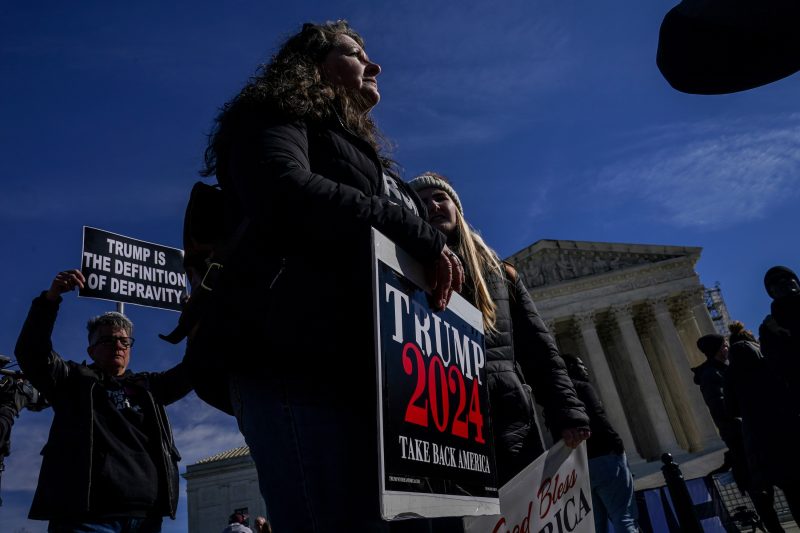A skeptical U.S. Supreme Court heard arguments Thursday in a momentous case that is expected to determine whether Donald Trump can continue his run for president.
At issue is a provision of the 14th Amendment of the Constitution that bars insurrectionists from office. Six Republican and independent voters from Colorado sued to block Trump from the ballot in that state, arguing he had engaged in insurrection before and during the attack on the U.S. Capitol on Jan. 6, 2021. Colorado’s high court in December agreed with them and found he was ineligible to run in the state’s primary.
The state court allowed Trump to appear on the primary ballot as he appealed the case to the Supreme Court. The justices heard arguments Thursday and are expected to issue a decision that will determine for all states whether the leading candidate for the Republican nomination can seek to return to the White House.
Here are four key takeaways from the arguments.
From the moment the Colorado voters filed their lawsuit, legal observers said they would have a tough time before a court that has a 6-3 conservative majority and includes three members who were nominated by Trump. Thursday’s arguments strengthened the predictions that Trump would win the case and be allowed to run in Colorado and elsewhere.
Chief Justice John G. Roberts Jr. raised concerns about the difficulty of determining whether specific individuals committed insurrection, asking who was responsible for making that judgment. Justice Brett M. Kavanaugh asked whether it was anti-democratic to prevent people from voting for a major candidate and whether excluding Trump would effectively disenfranchise his voters. And Justice Samuel A. Alito Jr. said allowing individual states to decide the issue could result in a patchwork of rulings, with each one following different evidentiary standards and reaching different conclusions about whether candidates are allowed to run.
“Suppose we have two different records, two different bodies of evidence, two different rulings on questions of admissibility, two different standards of proof, two different sets of fact-findings by two different judges, or maybe multiple judges in multiple states,” Alito said. “Then what do we do?”
It wasn’t just members of the court’s conservative majority who were asking tough questions. The liberals had their share of them, too.
Justice Elena Kagan expressed reservations, saying one state’s ruling could decide the issue for others. “Why should a single state have the ability to make this determination not only for their own citizens but for the rest of the nation?” she asked.
The question got at a truism of American politics: Presidential elections are decided by just a handful of swing states. Kicking a candidate off the ballot in one or two key states could make their run for office impossible, even if they remain on the ballot elsewhere.
“That seems quite extraordinary, doesn’t it?” Kagan asked Jason Murray, the attorney for the Colorado voters who brought the case.
Justice Ketanji Brown Jackson noted Section 3 bars insurrectionists from serving as presidential electors but does not say anything about presidents. She suggested those who wrote Section 3 may have been focused on officials at the local and state level rather than national figures.
“The thing that really is troubling to me is … they were listing people that were barred, and president is not there,” she said. “And so I guess that just makes me worry that maybe they weren’t focusing on the president.”
The justices focused on whether states had the power to remove candidates from the ballot under Section 3, rather than the details of what happened Jan. 6.
That was bad news for the plaintiffs. Even worse was that when the topic of insurrection did come up, justices appeared focused on poking holes in the arguments of those seeking Trump’s disqualification.
Roberts questioned Murray about the difficulties of determining when someone commits insurrection. He voiced skepticism about a scenario in which “we would be deciding whether it was an insurrection when one president did something as opposed to when somebody else did something else,” and which of those acts amounted to insurrection.
“There’s a reason Section 3 has been dormant for 160 years, and it’s because we haven’t seen anything like January 6,” Murray said.
“It seems to me you’re avoiding the question” about the definition of an insurrectionist, Roberts replied.
Alito echoed an argument from Trump that a ruling to keep him off the ballot would lead to partisans attempting to punish their political rivals by routinely trying to prevent them from running for office.
Murray noted that, until Jan. 6, there hasn’t been anything like an insurrection since the Civil War. Alito responded that the past could not predict the future, noting that there were no impeachments of presidents for 100 years, and “in fairly short order over the last couple of decades, we’ve had three.”
For his part, Trump attorney Jonathan Mitchell argued the attack on the U.S. Capitol was a “riot, not an insurrection.” He said an insurrection required an organized, concerted and violent attempt to overturn the government.
Kavanaugh, meanwhile, asked Murray whether the Colorado decision would disenfranchise Trump’s supporters.
“What about the idea that we should think about democracy, think about the right of the people to elect candidates of their choice, of letting the people decide?” Kavanaugh asked.
Murray replied that “safeguarding democracy” goes beyond letting people vote for the person they prefer to see in office. “Our Constitution protects us from insurrectionists” who “could dismantle our constitutional democracy from within,” Murray said.
But none of the justices pressed Mitchell on that point.
The justices expressed worries that different states could reach different conclusions about Trump’s eligibility as it stands now. That suggests they will issue a decision that will resolve the matter for all states.
That’s what many legal scholars and election officials have been asking for. They have said states need clarity about who can run, especially now that primaries are already underway.
The justices have not said how soon they will rule but seemed to acknowledge they need to move quickly by scheduling arguments soon after they accepted the case. Those who brought the case asked the justices to rule before March 5.
That’s the day when Colorado and 14 other states hold their primaries in what is known as Super Tuesday. If Thursday’s Supreme Court arguments were any indication, voters will have a chance to render a verdict on Trump then.
Washington Post reporters Devlin Barrett, Perry Stein, Rachel Weiner, Tobi Raji, Ann E. Marimow and Sarah Ellison contributed to this report.



























